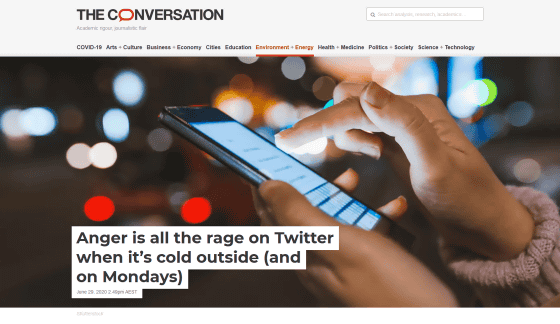Research results that there are many 'angry tweets' on cold days

It has been known from previous studies that 'temperature' has a great influence on human behavior and emotions. Research results indicate
In Cold Weather We Bark, But in Hot Weather We Bite: Patterns in Social Media Anger, Aggressive Behavior, and Temperature-Heather R. Stevens, Petra L. Graham, Paul J. Beggs, Ivan C. Hanigan,
https://journals.sagepub.com/doi/10.1177/0013916520937455
Anger is all the rage on Twitter when it's cold outside (and on Mondays)
https://theconversation.com/anger-is-all-the-rage-on-twitter-when-its-cold-outside-and-on-mondays-141589

In Australia, with a population of approximately 25 million, over 70% of the total population, 18 million people, use some form of social media, and nearly 20% of the population, 4.7 million, are Twitter users. Twitter seems to be a social media that researchers can easily analyze, and the research team
Tweets on Twitter can be associated with the posted date, time, place, age, and gender, so it is possible to read the 'user's overall emotional tendency' in the framework of each city or country. .. The research team used We Feel to analyze sentiment of 74.2 million English tweets tweeted in New South Wales in southeastern Australia from 2015 to 2017.
Of the 74.2 million tweets analyzed, 3.87% or 3.87% of the tweets were associated with anger, such as 'hated,' 'disgusted,' and 'f*cked.' Words were used. The research team matched the number of tweets that contained anger with changes in temperature in New South Wales.

According to the research team, the number of angry tweets was highest on a cold day with a maximum temperature of 15 degrees or less, and the number of angry tweets was the lowest when the maximum temperature was in the range of 25 to 30 degrees. It seems that the number of tweets that were slightly angry increased when the maximum temperature exceeded 35 degrees, but since the number of samples on the day when the maximum temperature exceeded 35 degrees was small, this trend is not so certain Research team Points out.
The number of angry tweets was 3354 per day on average during the 10 days with the lowest maximum temperature during the survey period, and 2482 per day on average during the 10 days with the highest maximum temperature. It turns out that it has a lot to do with the number of tweets. While it has been clarified that the physical aggression of people increases as the temperature rises, the aggression on Twitter is increasing on cold days.
The research team proposes two hypotheses as to why the difference between physical aggression and aggression on Twitter appeared. One is, ``Some people on Twitter on cold days due to differences in physiological responses such as heart rate, brain oxygen content, hormone secretion amount such as testosterone , sleep amount caused by hot and cold days. Increases aggression.'
The other is that 'differences in weather affect people's behavior, and as a result, more tweets are more aggressive on days with low temperatures.' There is a study that suggests that violent crimes increase on warm days 'because people spend more time outdoors, more people are interacting with them, and more alcohol is consumed.' The research team points out that being with someone else can lose the opportunity and motivation to tweet.
It is also possible that alcohol consumption complicates the operation of small smartphones and reduces tweet creation. This hypothesis is also consistent with the fact that the number of angry and overall tweets on hot days and weekends is decreasing.

It is also pointed out that this result is due to demographic differences between Twitter users and those who carry out offensive crimes. While violent criminals are more likely to be socio-economically disadvantaged young men, about half of Twitter users are women, more middle-aged and more profitable users than other social media. There are many. The research team is investigating how these social and demographic differences make a difference in the response to temperature.
This study focused mainly on the relationship between temperature and angry tweets, but the research team said that ``The average number of angry tweets was the highest on Monday'' ``Disastrous events such as political events and shootings The number of angry tweets increases after major events and big sporting events.'
The research team said, 'Our research was limited in that Twitter users did not necessarily represent a wide population. For example, Twitter is a popular media medium for politicians, scholars, and journalists. Yes, these users may or may not express emotions differently from other social media users.' Nevertheless, there is a research result that 'anger is the most influential emotion in social media', so anger on social media that increases with changes in temperature may affect a wider population. There is.

Related Posts:
in Web Service, Smartphone, Posted by log1h_ik







